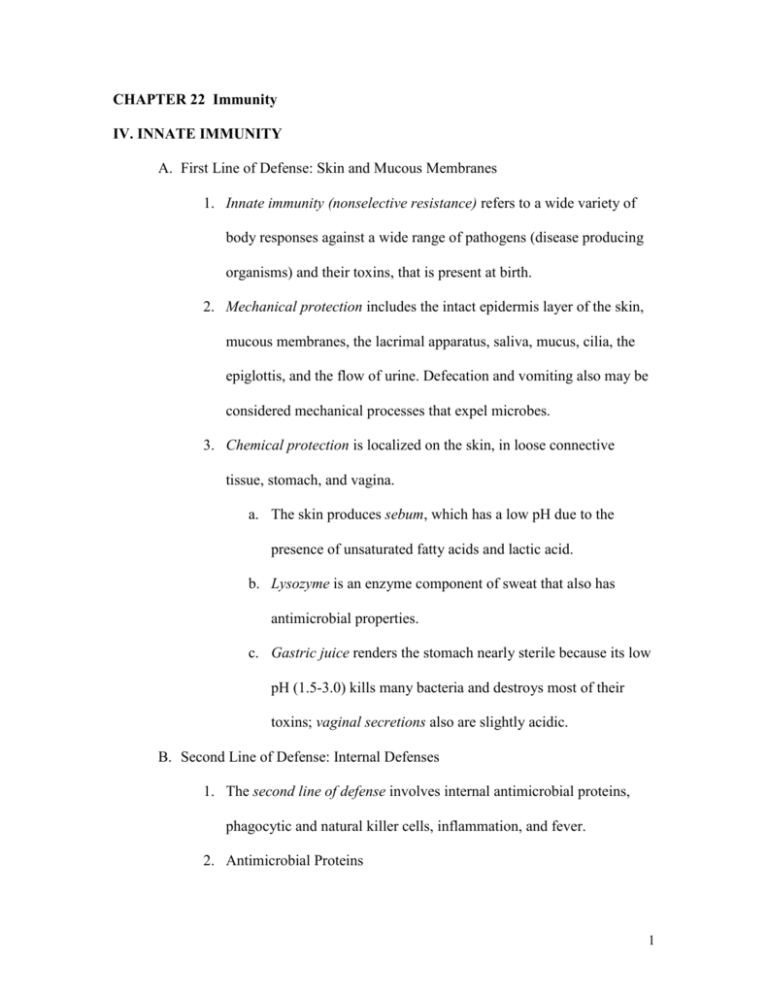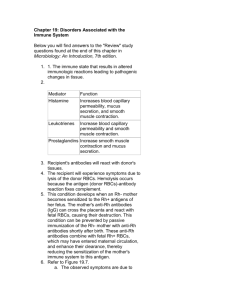ch22 Immunity
advertisement

CHAPTER 22 Immunity IV. INNATE IMMUNITY A. First Line of Defense: Skin and Mucous Membranes 1. Innate immunity (nonselective resistance) refers to a wide variety of body responses against a wide range of pathogens (disease producing organisms) and their toxins, that is present at birth. 2. Mechanical protection includes the intact epidermis layer of the skin, mucous membranes, the lacrimal apparatus, saliva, mucus, cilia, the epiglottis, and the flow of urine. Defecation and vomiting also may be considered mechanical processes that expel microbes. 3. Chemical protection is localized on the skin, in loose connective tissue, stomach, and vagina. a. The skin produces sebum, which has a low pH due to the presence of unsaturated fatty acids and lactic acid. b. Lysozyme is an enzyme component of sweat that also has antimicrobial properties. c. Gastric juice renders the stomach nearly sterile because its low pH (1.5-3.0) kills many bacteria and destroys most of their toxins; vaginal secretions also are slightly acidic. B. Second Line of Defense: Internal Defenses 1. The second line of defense involves internal antimicrobial proteins, phagocytic and natural killer cells, inflammation, and fever. 2. Antimicrobial Proteins 1 a. Lymphocyte and macrophage cells infected with viruses produce proteins called interferons (IFNs). Once produced and released from virus-infected cells, IFN diffuses to uninfected neighboring cells and binds to surface receptors, inducing uninfected cells to synthesize antiviral proteins that interfere with or inhibit viral replication. b. A group of about 20 proteins present in blood plasma and on cell membranes comprises the complement system; when activated, these proteins “complement” or enhance certain immune, allergic, and inflammatory reactions. c. Iron-binding proteins remove iron from the body fluids thereby inhibiting microbial growth. d. Anti-microbial substances are peptides that produce antimicrobial activity and attract dendritic and mast cells. 3. Natural Killer Cells and Phagocytes a. Natural killer (NK) cells are lymphocytes that lack the membrane molecules that identify T and B cells. 1) They have the ability to “kill” a wide variety of infectious microbes. 2) NK cells sometimes release perforins that insert into the plasma membrane of a microbe and make the membrane leaky so that cytolysis occurs 2 b. Phagocytes are cells specialized to perform phagocytosis and include neutrophils and macrophages. 1) The five phases of phagocytosis include chemotaxis, adherence, ingestion, digestion and killing (Figure 22.9). 2) After phagocytosis has been accomplished, a phagolysosome (Figure 22.9) is formed and the lysosome in the phagolysosome, along with lethal oxidants produced by the phagocyte, quickly kills many types of microbes. 4. Inflammation a. Inflammation occurs when cells are damaged by microbes, physical agents, or chemical agents. The injury may be viewed as a form of stress. 1) Inflammation is usually characterized by four symptoms: redness, pain, heat, and swelling. Loss of function may be a fifth symptom, depending on the site and extent of the injury. 2) The three basic stages of inflammation are:1) vasodilation and increased permeability of blood vessels; 2) phagocyte migration; and, 3) tissue repair (Figure 22.10). 3 3) Substances that contribute to inflammation are histamines, kinins, prostaglandins, leukotrienes, and complement. b. After phagocytes engulf damaged tissue and microbes, they eventually die, forming a pocket of dead phagocytes and damaged tissue and fluid called pus. Pus must drain out of the body or it accumulates in a confined space, causing an abscess. 5. Fever is usually caused by infection from bacteria (and their toxins) and viruses. The high body temperature inhibits some microbial growth and speeds up body reactions that aid repair. C. Table 22.1 summarizes the components of innate defenses. V. ADAPTIVE IMMUNITY A. Immunity is the ability of the body to defend itself against specific invading agents. 1. Antigens are substances recognized as foreign by the immune responses. 2. The distinguishing properties of immunity are specificity and memory. 3. The branch of science that deals with the responses of the body when challenged by antigens is called immunology. B. Maturation of T Cells and B Cells 1. Both T cells and B cells derive from stem cells in bone marrow (Figure 22.11). 4 a. B cells complete their development, becoming immunocompetent, in bone marrow (Figure 22.11). b. T cells develop from pre-T cells that migrate to the thymus where they become immunocompetent under the influence of thymic hormones 2. Before T cells leave the thymus or B cells leave bone marrow, they acquire several distinctive surface proteins; some function as antigen receptors, molecules capable of recognizing specific antigens. C. Types of Adaptive immunity 1. Cell-mediated immunity refers to destruction of antigens by T cells. It is particularly effective against intracellular pathogens, such as fungi, parasites, and viruses; some cancer cells; and foreign tissue transplants. CMI always involves cells attacking cells. 2. Antibody-mediated (humoral) immunity refers to destruction of antigens by antibodies. It works mainly against antigens dissolved in body fluids and extracellular pathogens, primarily bacteria, that multiply in body fluids but rarely enter body cells. 3. Often a pathogen provokes both types of immune response. D. Clonal selection 1. Clonal selection is the process by which an immune cells proliferates and differentiates in response to a specific antigen. 2. Two major types of cells result from clonal selection; 1) effector cells; and 2) memory cells. 5 3. Effector cells are the cells that actually do the work to destroy the antigen and include: cytotoxic T cells, helper T cells and plasma cells (a clone of B cells) 4. Memory cells, with long life spans, provide a faster second invasion response by proliferating and differentiating into effector cells. E. Antigens and Antigen Receptors 1. Antigens are chemical substances that are recognized as foreign by antigen receptors when introduced into the body. Antigens are both immunogenic and reactive. An antigen that gets past the nonspecific defenses can get into lymphatic tissue by entering an injured blood vessel and being carried to the spleen, penetrating the skin and entering lymph vessels leading to lymph nodes, or penetrating mucous membranes and lodging in mucosa-associated lymphoid tissue. 2. Antigens are large, complex molecules. They are most often proteins, but sometimes are nucleoproteins, lipoproteins, glycoproteins, and certain large polysaccharides. 3. Specific portions of antigen molecules, called antigenic determinants, or epitopes, trigger immune responses (Figure 22.12). 4. Major histocompatibility complex (MHC) antigens (also called human leucocyte associated, or HLA, antigens) are unique to each person’s body cells. These self-antigens aid in the detection of foreign invaders. All cells except red blood cells display MHC class I antigens. Some cells also display MHC class II antigens. 6 E. Pathways of Antigen Processing 1. For an immune response to occur, B and T cells must recognize that a foreign antigen is present. a. B cells can recognize and bind to antigens in extracellular fluid. b. T cells, however, can only recognize fragments of antigenic proteins that first have been processed and presented in association with MHC self-antigens. c. Peptide fragments from foreign antigens help stimulate MHC molecules. 2. Processing of Exogenous Antigens a. Cells called antigen-presenting cells (APCs) process exogenous antigens (antigens formed outside the body) and present them together with MHC class II molecules to T cells (Figure 22.13) b. APCs include macrophages, B cells, and dendritic cells. c. Steps in processing and presenting an exogenous antigen by an APC include ingestion of the antigen, digestion of antigen into peptide fragments, fusion of vesicles, binding of peptide fragments to MHC-II molecules, and insertion of antigenMHC-II complex into the plasma membrane. 3. Most cells of the body can process and present endogenous antigens, antigens that were synthesized in a body cell (e.g., viral proteins from virus-infected cells). The process is depicted in Figure 22.14) 7 F. Cytokines 1. Cytokines are small protein hormones needed for many normal cell functions. 2. Table 22.2 describes some of the cytokines that participate in immune responses. VI. CELL-MEDIATED IMMUNITY A. In a cell-mediated immune response, an antigen is recognized (bound), a small number of specific T cells proliferate and differentiate into a clone of effector cells (a population of identical cells that can recognize the same antigen and carry out some aspect of the immune attack), and the antigen (intruder) is eliminated. B. Activation of T Cells 1. T cell receptors recognize antigen fragments associated with MHC molecules on the surface of a body cell (Figrue 22.15) 2. Proliferation of T cells requires costimulation, by cytokines such as interleukin-1 (IL-1) and interleukin-2 (IL-2), or by pairs of plasma membrane molecules, one on the surface of the T cell and a second on the surface of an APC. C. Activation and clonal selction of helper T Cells 1. Helper T (TH) cells, or CD4 T cells, display CD4 protein, recognize antigen fragments associated with MHC-II molecules, and secrete several cytokines, most important, interleukin-2, which acts as a costimulator for other helper T cells, cytotoxic T cells, and B cells. 8 2. Once a helper T cell is activated it creates clones of other helper T and memory T cells (Figure 22.15). D. Activation and clonal selction of helper T Cells 1. Cytotoxic T (TC) cells, or CD8 T cells, develop from T cells that display CD8 protein and recognize antigen fragments associated with MHC-I molecules. 2 Once activated cytotoxic T cells undergo clonal selection to form more active cytotoxic T cells and memory cytotoxic T cells (Figure 22.16) E. Elimination of invaders Cytotoxic T cells fight foreign invaders by killing the target cell (the cell that bears the same antigen that stimulated activation or proliferation of their progenitor cells) without damaging the cytotoxic T cell itself (Figure 22.17). 1) One killing mechanism uses perforin to cause cytolysis of the target cell. 2) The second mechanism uses lymphotoxin to activate damaging enzymes within the target cell. VI. ANTIBODY-MEDIATED IMMUNITY A. The body contains not only millions of different T cells but also millions of different B cells, each capable of responding to a specific antigen. B. Activation and clonal selection of B Cells 1. During activation of a B cell, an antigen binds to antigen receptors on the cell surface (Figure 22.18). 9 a. B cell antigen receptors are chemically similar to the antibodies that will eventually be secreted by their progeny. b. Some antigen is taken into the B cell, broken down into peptide fragments and combined with the MHC-II self-antigen, and moved to the B cell surface. 2. Helper T cells recognize the antigen-MHC-II combination and deliver the costimulation needed for B cell proliferation and differentiation. 3. Some activated B cells become antibody-secretion plasma cells. Others become memory B cells. B. Antibodies 1. An antibody is a protein that can combine specifically with the antigenic determinant on the antigen that triggered its production. 2. Antibody Structure a. Antibodies consist of heavy and light chains and variable and constant portions (Figure 22.19). b. Based on chemistry and structure, antibodies are grouped into five principal classes each with specific biological roles (IgG, IgA, IgM, IgD, and IgE). Table 22.3 summarizes the structures and functions of these five classes of antibodies. C. Antibody actions 1.The functions of antibodies include neutralizing antigen, immobilization of bacteria, agglutination and precipitation of antigen, activation of complement and enhancing phagocytosis. 10 2. Monoclonal antibodies are pure antibodies produced by fusing a B cell with a tumor cell that is capable of proliferating endlessly. The resulting cell is called a hybridoma. Monoclonal antibodies are important in measuring levels of a drug in a patient’s blood and in the diagnosis of pregnancy, allergies, and diseases such as hepatitis, rabies, and some sexually transmitted diseases. They have also been used in early detection of cancer and assessment of extent of metastasis. They may be useful in preparing vaccines to counteract transplant rejection, to treat autoimmune diseases, and perhaps to treat AIDS. (Clinical Connection) D. Role of Complement system in immunity A group of about 20 proteins present in blood plasma and on cell membranes comprises the complement system; when activated, these proteins “complement” or enhance certain immune, allergic, and inflammatory reactions (Figure 22.20). 11








